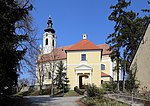The Battle of Wagram ([ˈvaɡram]; 5–6 July 1809) was a military engagement of the Napoleonic Wars that ended in a costly but decisive victory for Emperor Napoleon's French and allied army against the Austrian army under the command of Archduke Charles of Austria-Teschen. The battle led to the breakup of the Fifth Coalition, the Austrian and British-led alliance against France. Wagram was the largest battle in European history up to its time.
In 1809, the French military presence in the Confederation of the Rhine was diminished as Napoleon transferred a number of soldiers to fight in the Peninsular War. As a result, the Austrian Empire saw its chance to recover some of its former sphere of influence and invaded the Kingdom of Bavaria, a French ally. Recovering from his initial surprise, Napoleon beat the Austrian forces and occupied Vienna at the beginning of May 1809. Despite the string of sharp defeats and the loss of the empire's capital, Archduke Charles salvaged an army, with which he retreated north of the Danube. This allowed the Austrians to continue the war. Towards the end of May, Napoleon resumed the offensive, suffering a surprise defeat at the Battle of Aspern-Essling.
It took Napoleon six weeks to prepare his next offensive, for which he amassed a 172,000-man French, German and Italian army in the vicinity of Vienna. The Battle of Wagram began after Napoleon crossed the Danube with the bulk of these forces during the night of 4 July and attacked the 136,000-man strong Austrian army. Having successfully crossed the river, Napoleon attempted an early breakthrough and launched a series of evening attacks against the Austrian army. The Austrians were thinly spread in a wide semicircle, but held a naturally strong position. After the attackers enjoyed some initial success, the defenders regained the upper hand and the attacks failed. Bolstered by his success, the next day at dawn Archduke Charles launched a series of attacks along the entire battle line, seeking to take the opposing army in a double envelopment. The offensive failed against the French right but nearly broke Napoleon's left. However, the Emperor countered by launching a cavalry charge, which temporarily halted the Austrian advance. He then redeployed IV Corps to stabilise his left, while setting up a grand battery, which pounded the Austrian right and centre. The tide of battle turned and the Emperor launched an offensive along the entire line, while Maréchal Louis-Nicolas Davout drove an offensive, which turned the Austrian left, and rendered Charles's position untenable. Towards mid-afternoon on 6 July, Charles admitted defeat and led a retreat, frustrating enemy attempts to pursue. After the battle, Charles remained in command of a cohesive force and decided to retreat to Bohemia. However, the Grande Armée eventually caught up with him and scored a victory at the Battle of Znaim. With the battle still raging, Charles decided to ask for an armistice, effectively ending the war.
With 74,000 casualties, the two-day battle of Wagram was particularly bloody, mainly due to the use of 800 artillery pieces and the expenditure of 200,000 rounds of artillery ammunition on a flat battlefield packed with some 300,000 men. Although Napoleon was the uncontested winner, he failed to secure an overwhelming victory and the Austrian casualties were only slightly greater than those of the French and allies. Nonetheless, the defeat was serious enough to shatter the morale of the Austrians, who could no longer find the will to continue the struggle. The resulting Treaty of Schönbrunn meant the loss of one sixth of the Austrian Empire's subjects, along with some territories, rendering it landlocked until the German Campaign of 1813.
After the battle, Emperor Napoleon bestowed to Louis-Alexandre Berthier, who was his Marshal, Chief of Staff, Minister of War and Vice-Constable of the Empire, the victory title of 1st Prince of Wagram, making him an official member of the French nobility. Berthier had previously been granted the title of Sovereign Prince of Neuchâtel and the Prince of Valangin in 1806. This allowed his descendants to carry the titles of Prince and Princess of Wagram.








